Panettone is a sweet, soft, and buttery bread similar to brioche but it is loaded with candied orange, raisins, currents, and baked in a paper mold. It's also referred to as Italian Christmas bread because it is traditionally baked for the Holidays and shared with friends and family. You only need 20 minutes of active work time to make this bread! The rest is letting the dough rise and bake! Super easy!
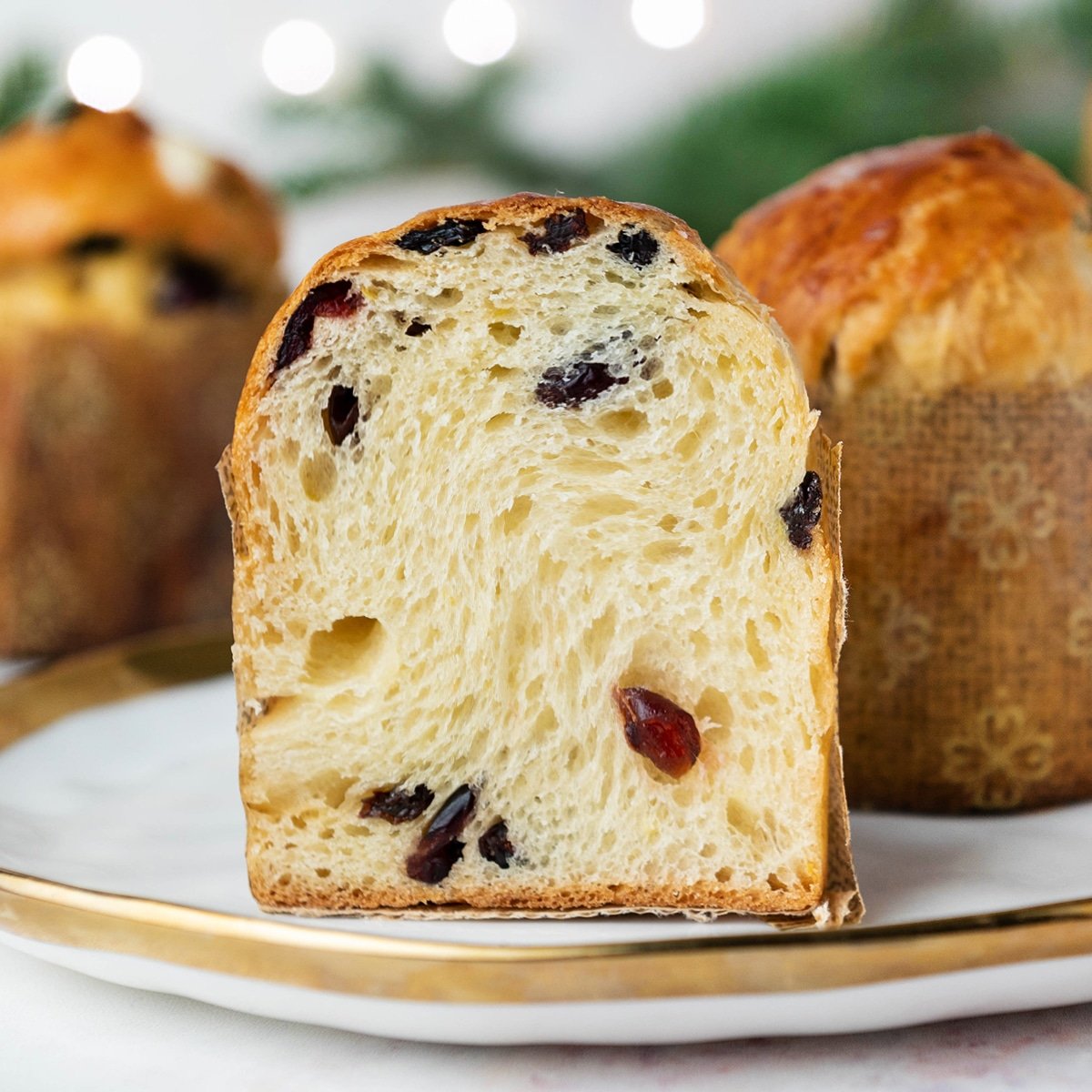
This recipe is inspired by the original creator of the slow-rise Pannetone (Jim Lahey from Sullivan Street Bakery's) recipe from Gourmet magazine that uses a cold rise method. This is the PERFECT way to make Panettone in my opinion because it's so easy to make the day before and bake it up fresh when you're ready to eat it. Plus the longer rise time adds a wonderful depth of flavor to the Panettone.
Dividing the dough into individual Panettone wrappers is fantastic for Holiday parties or events and makes serving super easy. If you'd rather bake a loaf you can use this recipe for that too!
What's in this blog post
Panettone ingredients
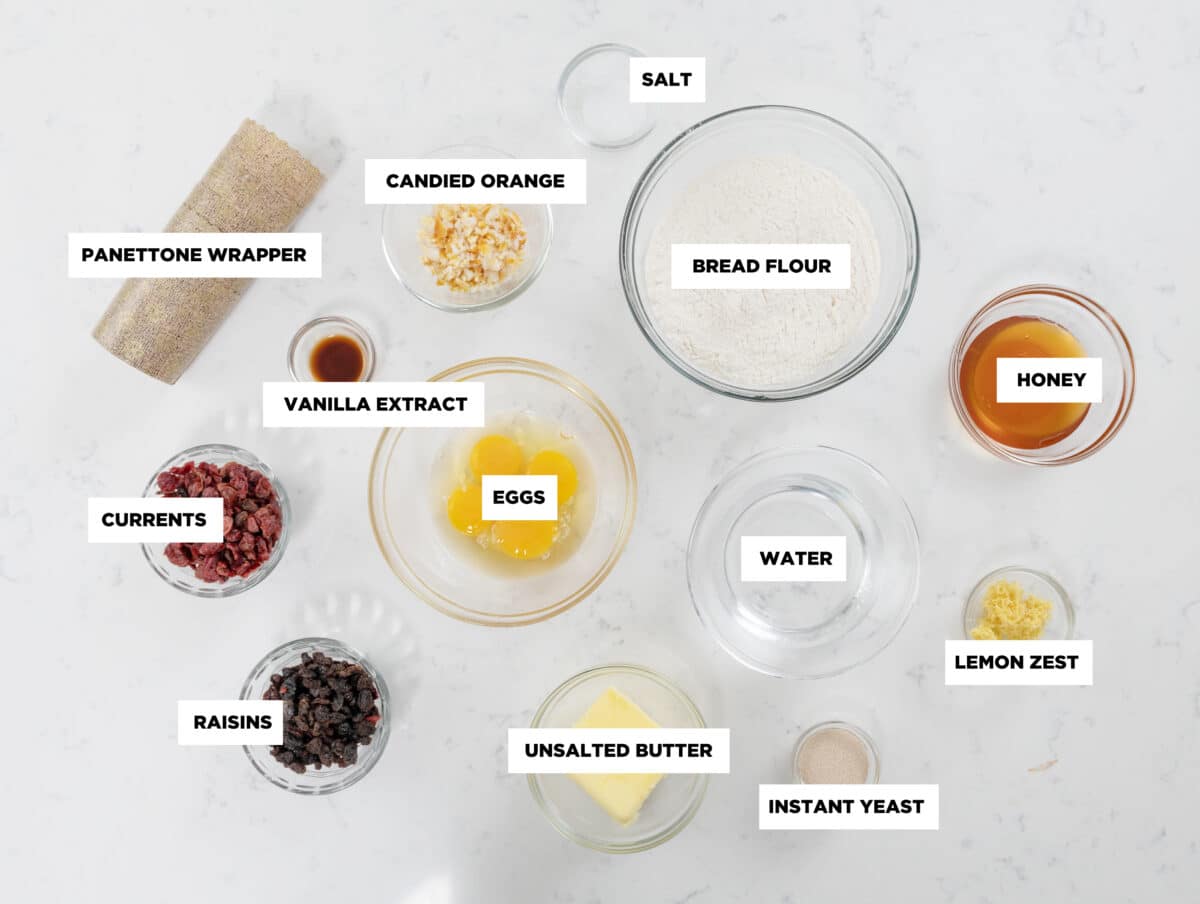
Traditionally, Panettone is filled with candied oranges, raisins, currants, and zest but you can really be creative with your Panettone filling.
Classic Panettone usually calls for the raisins to be soaked in rum for at least 8 hours to make them plump but for this recipe, we are skipping that step because modern-day raisins are already pretty soft and plump. I did do one test where I used soaked raisins and they kind of shredded apart during the mixing process.
Panettone is usually made with sourdough starter but modern recipes use instant yeast to make a sponge which speeds along the process without sacrificing flavor. If you don't have instant yeast you can use dry active yeast but keep in mind you may have to let your dough rise for longer to double in size.
You will also need some Panettone wrappers. I'm using these smaller ones but they come in literally dozens and dozens of sizes. I didn't have much luck finding them in stores locally so be prepared to buy some online. You could use cupcake wrappers if you can't find Panettone wrappers.
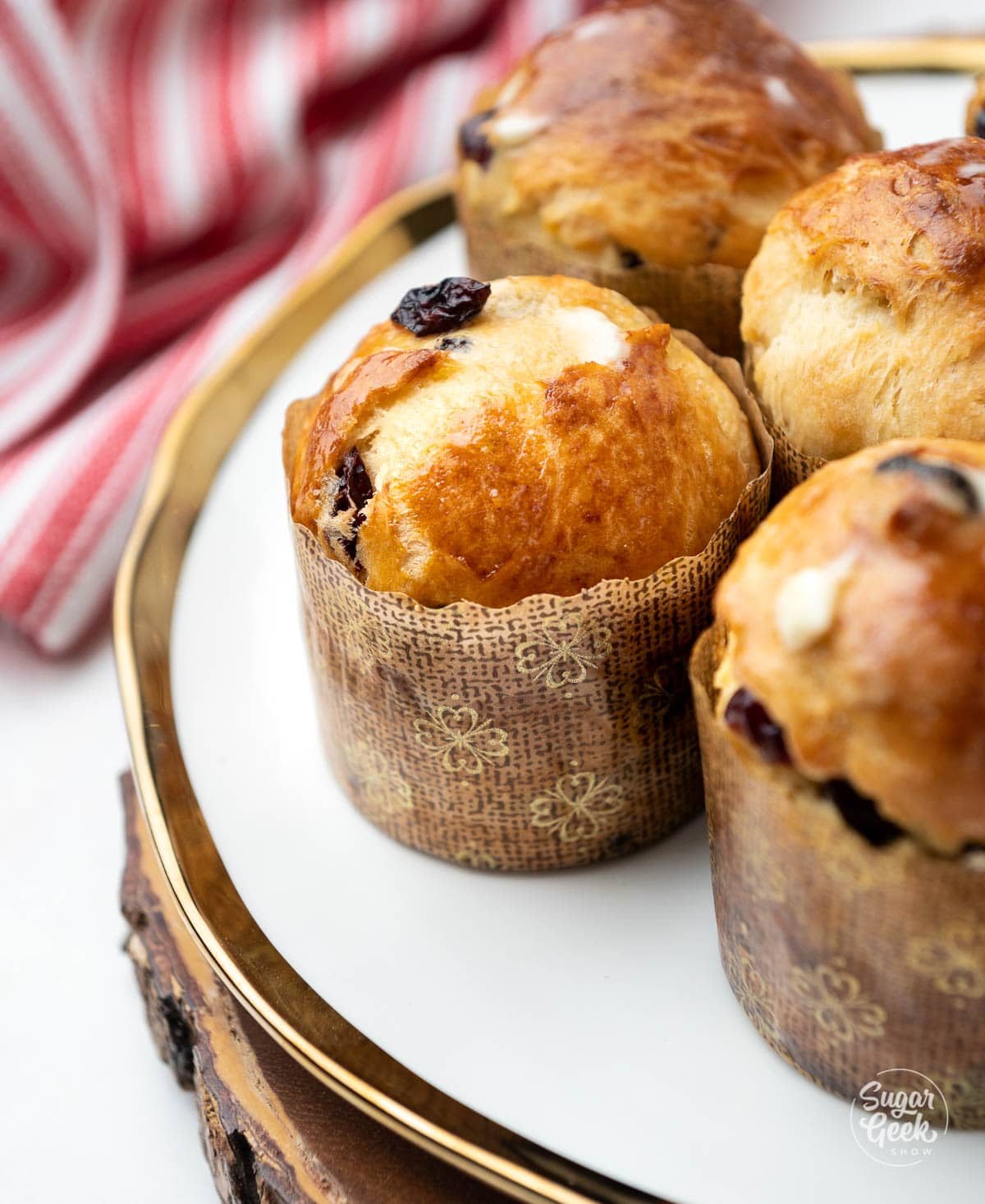
Creative Panettone flavor options
Pistachio Cranberry Panettone - dried cranberries, pistachios, orange zest
Chocolate Orange Panettone - candied oranges, cocoa powder, chocolate chips
Black Forest Panettone - dried cherries, candied oranges, chocolate chips
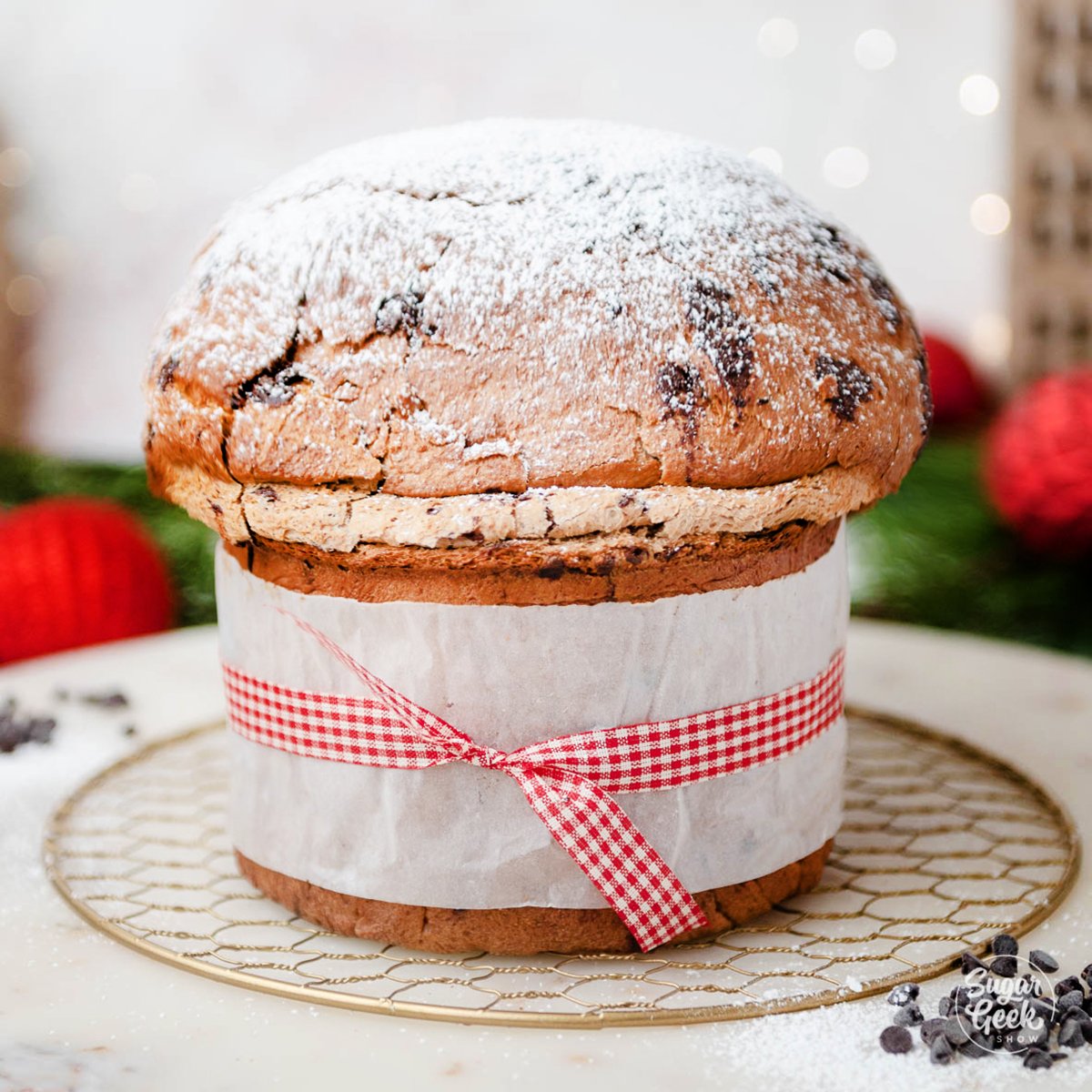
How to make panettone step-by-step
Making this slow-rise Panettone only requires 20 minutes of actual work time. The rest of the time is giving your dough time to develop flavor and for yeast to do its thing. This is what your schedule should look like.
Day 1 Evening - Make the sponge. Cover it with plastic wrap and place it into the fridge to rise overnight.
Day 2 Morning - Make the dough and set it in a warm place to rise for 30 minutes.
Day 2 Midday - Dived dough into panettone wrappers and let them rise for 30 minutes or place into the fridge overnight to bake the next morning.
Day 2 - Bake and enjoy!
For the sponge
- In a medium sized bowl, sprinkle the yeast into the flour and stir until combined.
- Add in the water, and stir until all the flour is moistened.
- Place the sponge into a bowl and cover it with plastic wrap.
- Place the sponge into the fridge overnight to develop flavor and allow time for the flour to absorb the water.
For the dough
Make sure your eggs and butter are at room temperature. Room temperature ingredients are important for creating a proper emulsion (ingredients that are mixed together cohesively). Keep in mind room temperature is typically about 72ºF and may take several hours to come to room temperature naturally. This is why I usually warm my eggs in a bowl of warm water and microwave my butter carefully to soften it. I rarely remember to take my ingredients out soon enough to naturally come to room temperature.
I also take my sponge out of the fridge about 30 minutes before I use it so it's not too cold.
- Combine the flour and salt together in a bowl and set it aside.
- In the bowl of your stand mixer, cream the softened butter and honey together with the paddle attachment until smooth.
- While mixing on low, add in the room temperature eggs one at a time, letting the first one mix in fully before adding in the next.
- Then add in the vanilla and mix until smooth and no longer curdled.
- While mixing on low, add in the sponge to the egg/butter mix. The dough will look broken, mix until its uniform in texture.
- Add in the flour, mix it until it all comes together. About 3 minutes.
- Switch to your dough hook.
- Mix on medium-low for 8 minutes to develop the panettones structure or until the dough looks fairly smooth and passes the windowpane test. (Pull a small piece of dough off and gently stretch it between your fingers to make it as thin as possible. If you can do this without it tearing, it's ready for the next step).
- Add in the dried fruits, zest and salt and mix until combined.
- Cover the bowl with plastic wrap and let the dough rise at room temperature for 30 minutes.
- If you are using the mini panettone papers portion your dough into about 3 oz balls using a scale.
- Roll the pieces of dough into balls by tucking the edges to the underside of the ball.
- Place the balls into panettone papers and then place onto a sheet pan. This should make approximately 25 mini pannetone. You can also use larger papers or loaf pans lined with parchment paper.
- Cover the panettone lightly with plastaic wrap and let them proof in the papers for about 30 min or until they double in size. If your dough is cold from fermenting in the fridge, this could take longer.
- Brush the tops of the doughs with an egg wash (mixed egg/yolk and a pinch of salt).
- Bake the panettone for approximately 25 minutes. This time will vary depending on the size of bread you are baking. The bread is done with it is nicely browned on top and has an internal temp of about 200ºF.
- Let the panettone cool slightly before eating but its best enjoyed warm with some butter and jam! Yum!
I love eating leftover Panettone (yes on rare occasions that happens) by toasting it and smothering it in butter.
Note: Panettone baked in larger wrappers should be cooled upside down to prevent collapse. Place two skewers into the base of your loaf and flip it upside down inside a large pot or supported by two containers until the loaf is barely warm to the touch.
An added bonus of making your panettone in mini papers is that you don't have to take that extra step of letting your panettone cool upside down to prevent collapse.
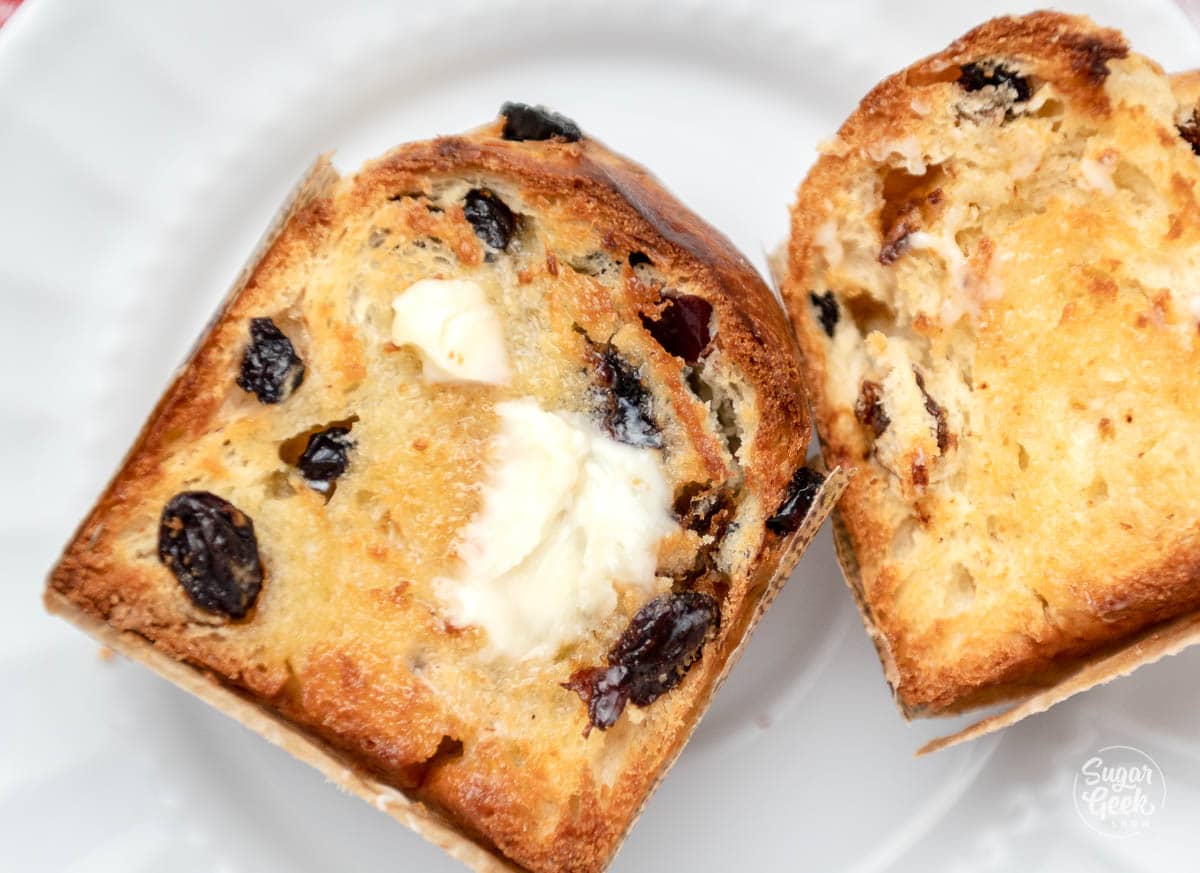
FAQ
Technically I will call this a bread based on its leavening with yeast and use of bread flour. It is a sweet bread enriched with butter, honey, and fruit, intended to be eaten as a treat as cake would, so that may be where it gets its ambiguous category.
Traditionally in Italy it is eaten with mascarpone cheese and a sweet liqueur, I like to eat it warm or toasted with butter and a cup of hot coffee!
This is an enriched bread with butter and sugar and fruits, and higher quality flours which were traditionally more expensive, making it more of a treat that you wouldn't splurge on the rest of the year.
Wrap it in plastic wrap and either freeze for later enjoyment or wrap it and leave it at room temp if you intend to finish the bread within a week. Refresh bread by lightly toasting it or warming it in the oven before eating.
It is a rich bread much like brioche, but with the bright sweet surprise of fruit and citrus.
The correct pronunciation of panettone is pah-neht-tohn
Yes! There are many variations of this traditional bread, probably as many as there are families in Italy. Before store-bought yeast was available sourdough was a common leavening agent for bread. You can swap the pre-ferment with your sourdough starter in equal parts. Make sure your starter is well fed and active, not too sour, and not too loose, a bit stiffer starter will perform better in this dough. Sourdough will move slower, so if you choose to try it with a starter it will double all of your proofing time, so be patient!
What is panettone?
Panettone is a sweet bread baked with fruits and raisins that is traditionally enjoyed during the holiday season. This bread is often confused with a cake because of its tender, buttery cake-like texture.
Understanding how yeast works
The basics of making a yeast-risen dough are all the same but different recipes may have slightly varied steps. This guide can help you understand how yeast-risen doughs work if you're not familiar.
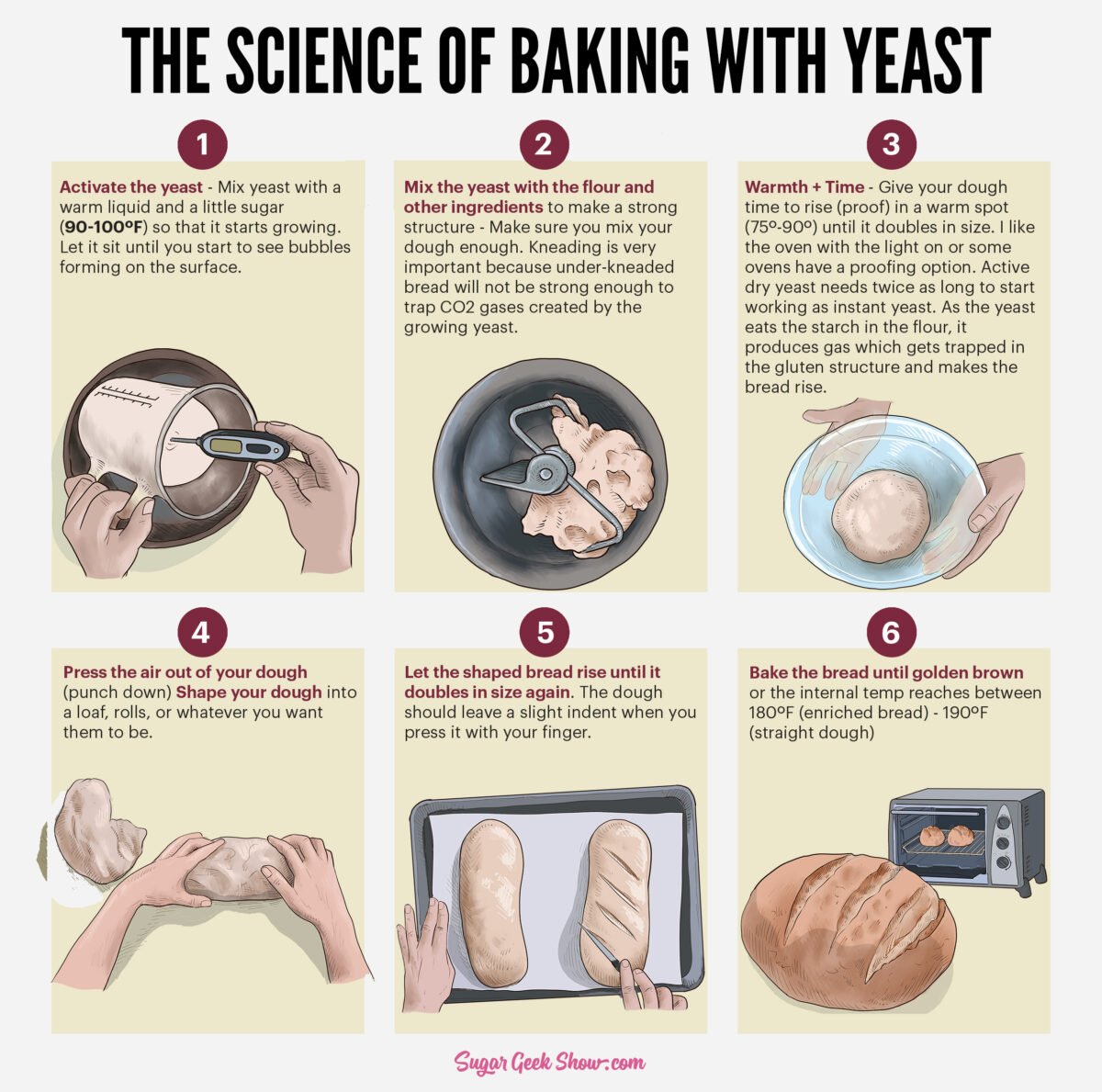
Here you'll see an infographic showing you the steps of baking bread using yeast. While this graphic is not specific to this panettone recipe, it gives you a general idea of the steps needed to use yeast leading up to when it's time to bake your bread.
- Activate the yeast – Mix yeast with a warm liquid (90-100ºF) so that it starts growing.
- Develop a strong gluten structure – Make sure you mix your dough enough. It should look like a smooth ball and pass the windowpane test. Kneading is very important because under-kneaded bread will not be strong enough to trap CO2 gases created by the growing yeas and therefore will not rise.
- Warmth + Time – Give your dough time to rise (proof) in a warm spot (80º-90º) until it doubles in size. I like the oven with the light on or some ovens have a proofing option. If you’re using instant yeast, the rising will happen a lot faster if you are using regular active yeast it will take longer. Cold environments will also stunt your yeast and your dough will take a lot longer to rise.
- Shape your dough to prepare your panettone (jump to the recipe to see the additional steps).
- Let it rise until it doubles in size again and then bake!
When you add yeast to the flour and add in warmth and a little bit of moisture, the yeast begins to eat the starch in the flour. As it eats the sugar, it produces CO2 (yes, bread is made of tiny yeast farts). Then that CO2 gets trapped in the gluten we developed during the mixing stage and expands, giving rise to your bread. If you’re missing one of these steps, your panettone won’t turn out.
But don’t worry! I’m going to walk you through this step-by step! You got this!
How to store leftover panettone
To store leftover panettone, wrap it tightly using plastic wrap and then place it in a resealable bag or wrap it in foil. Homemade panettone will stay fresh at room temperature if stored correctly for up to 7 days.
If you wish to freeze your homemade panettone, you can either freeze it in slices or as a loaf. You will need to wrap the leftovers with plastic wrap, and then store it in a sealed, freezer-safe bag. The panettone can be frozen for up to 3 months. Then when it’s time to defrost your panettone, take it out of the freezer and pop it in the refrigerator to begin to thaw (then move it to the kitchen counter to bring it to room temperature which will take several hours).
You might also like
Soft homemade brioche bread recipe
Grandma's sweet Irish soda bread recipe
Recipe

Equipment
- 2.75" Panettone Wrappers
Ingredients
Sponge
- 8 ounces water 70ºF
- 15 grams instant yeast
- 10 ounces bread flour
Dough
- 8 ounces butter (room temperature) softened
- 4 ounces honey
- 1 teaspoon salt
- 2 eggs (room temperature)
- 2 egg yolks (room temperature)
- 1 teaspoon vanilla
- 12 ounces bread flour
- 3 ounces raisins
- 2 ounce candied orange peel
- 3 ounces dried cranberries
- 2 ounces dried currants
- 1 tablespoon lemon zest
Instructions
For the sponge
- Mix yeast into flour, add to water, and mix until smooth.
- Cover and place in fridge until double in size or overnight.
For the dough
- In a bowl, combine 12 ounces of flour with salt. Set aside.
- In your stand mixer, cream the softened butter and honey.
- Slowly add eggs, yolks, and vanilla. Mix until almost combined, the eggs and butter wont fully incorprate at this stage.
- Add sponge to the egg/butter mix. The dough will look broken, mix until it uniform in texture, then add flour, mix until it all comes together, about 3 minutes. Switch to your dough hook.
- Add the fruits and zest into the dough and mix with dough hook on low for 8 minutes to develop gluten.
- Cover the bowl and let dough rise for 30 minutes at room temp. If you need more time place dough in the fridge to ferment slower.
- If you are using the mini panettone papers portion your dough into about 3 oz balls and place into papers. This should make approximately 25 mini pannetone. You can also use larger papers or loaf pans.
- Cover lightly and let proof in the papers for about 30 min, if your dough is cold from fermenting in the fridge, this could take longer.
- Brush the tops of the doughs with an egg wash (mixed egg/yolk and a pinch of salt). On a sheet pan evenly spaced, place panettone into a 375* oven for approximately 25 minutes. This time will vary on the size of bread you are baking. The bread is done with it is nicely browned on top and has an internal temp of about 200* when a probe thermometer is inserted into the middle.
- Let breads cool, but can be enjoyed warm.
Video
Notes
- Instant yeast is best for this recipe so rise times are not as long. See the blog post for yeast substitutions using an active dry or sourdough starter.
- Brush your Panettone before you bake it with egg wash for a golden, shiny finish.
- If you're baking a large loaf, be sure to cool it upside down using skewers to prevent the loaf from collapsing. (see photo in blog post)




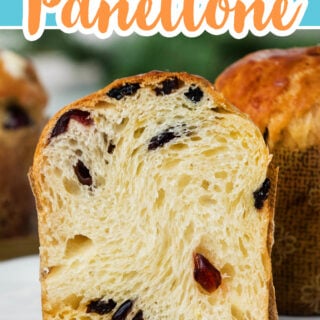
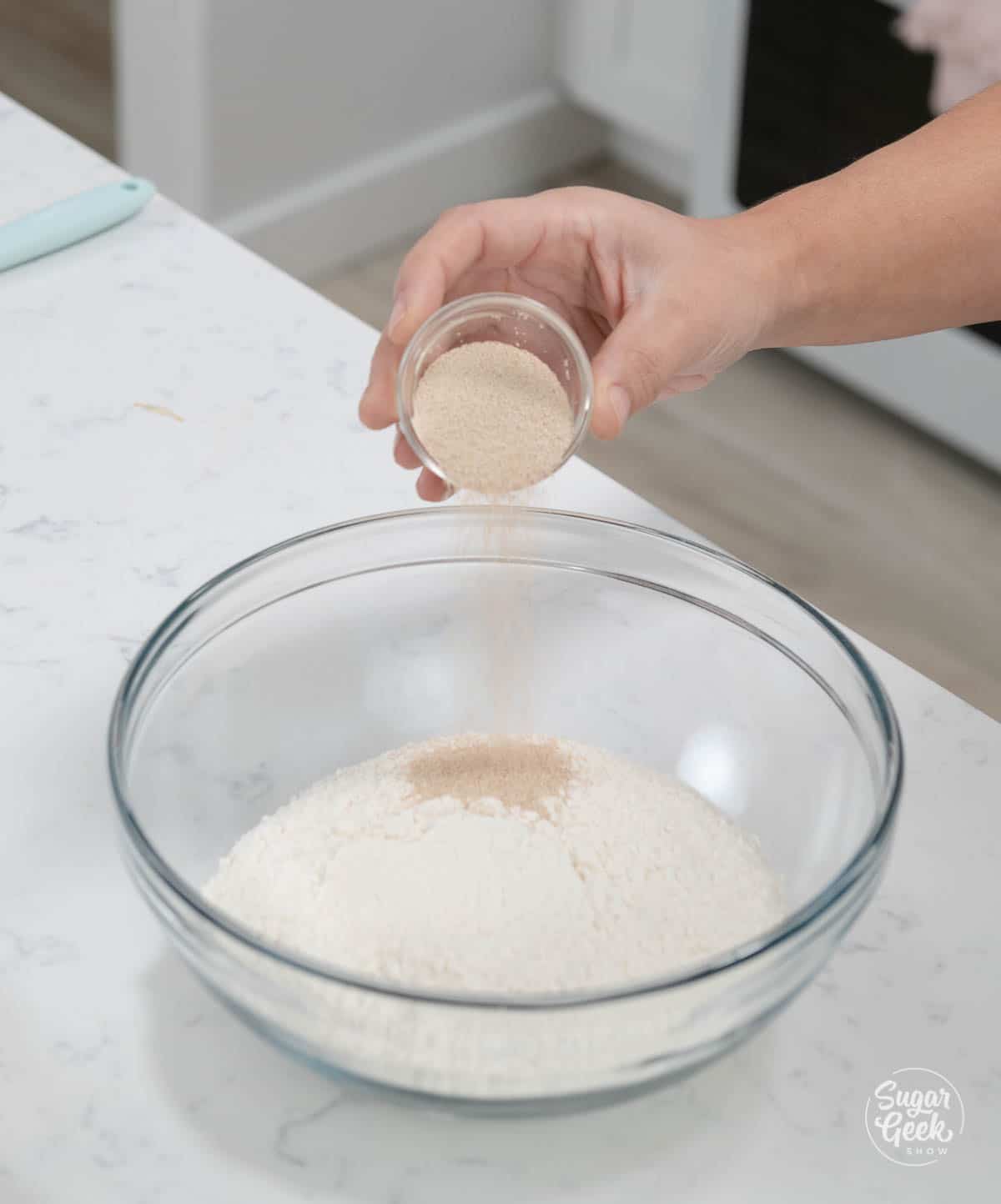
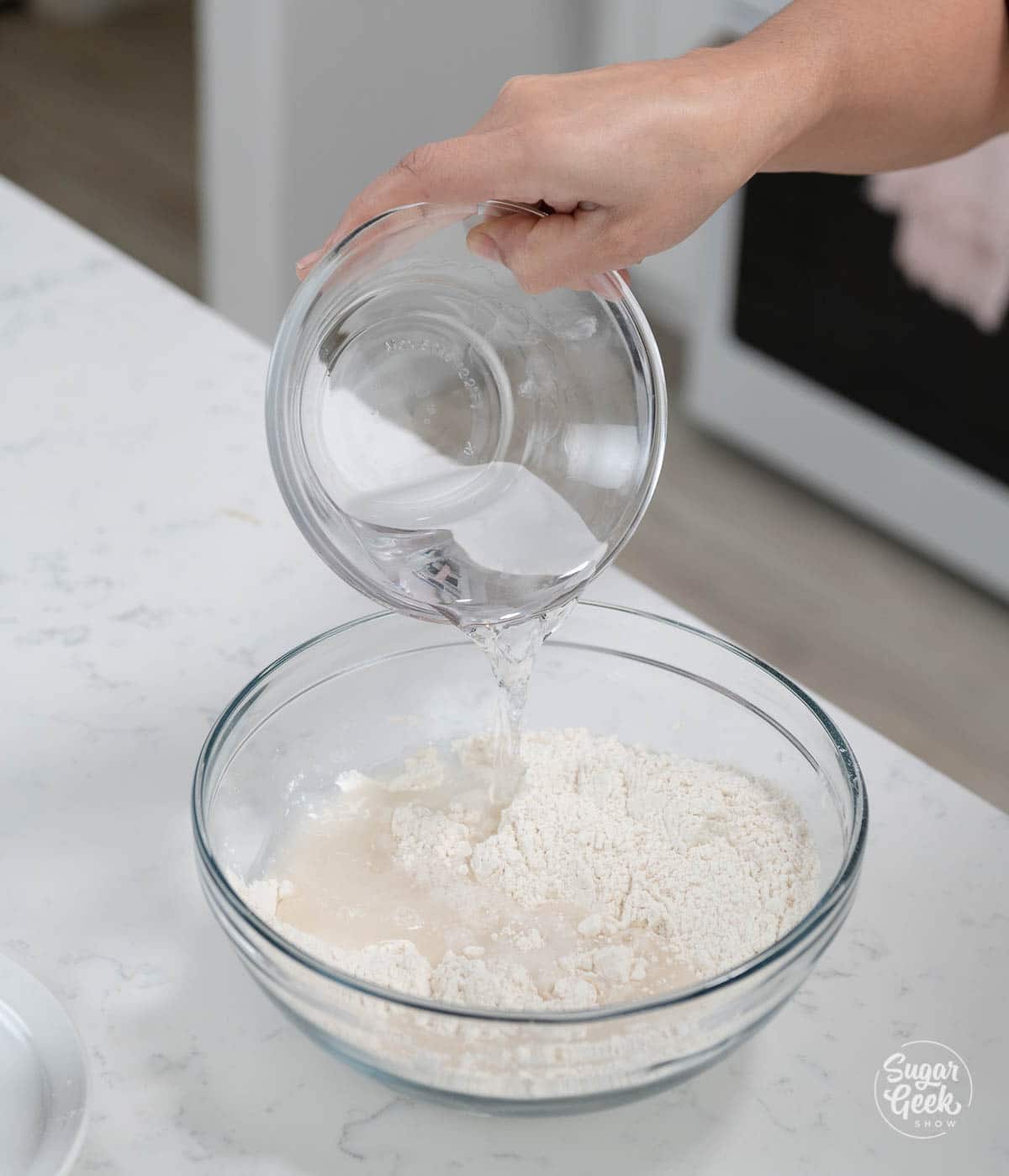
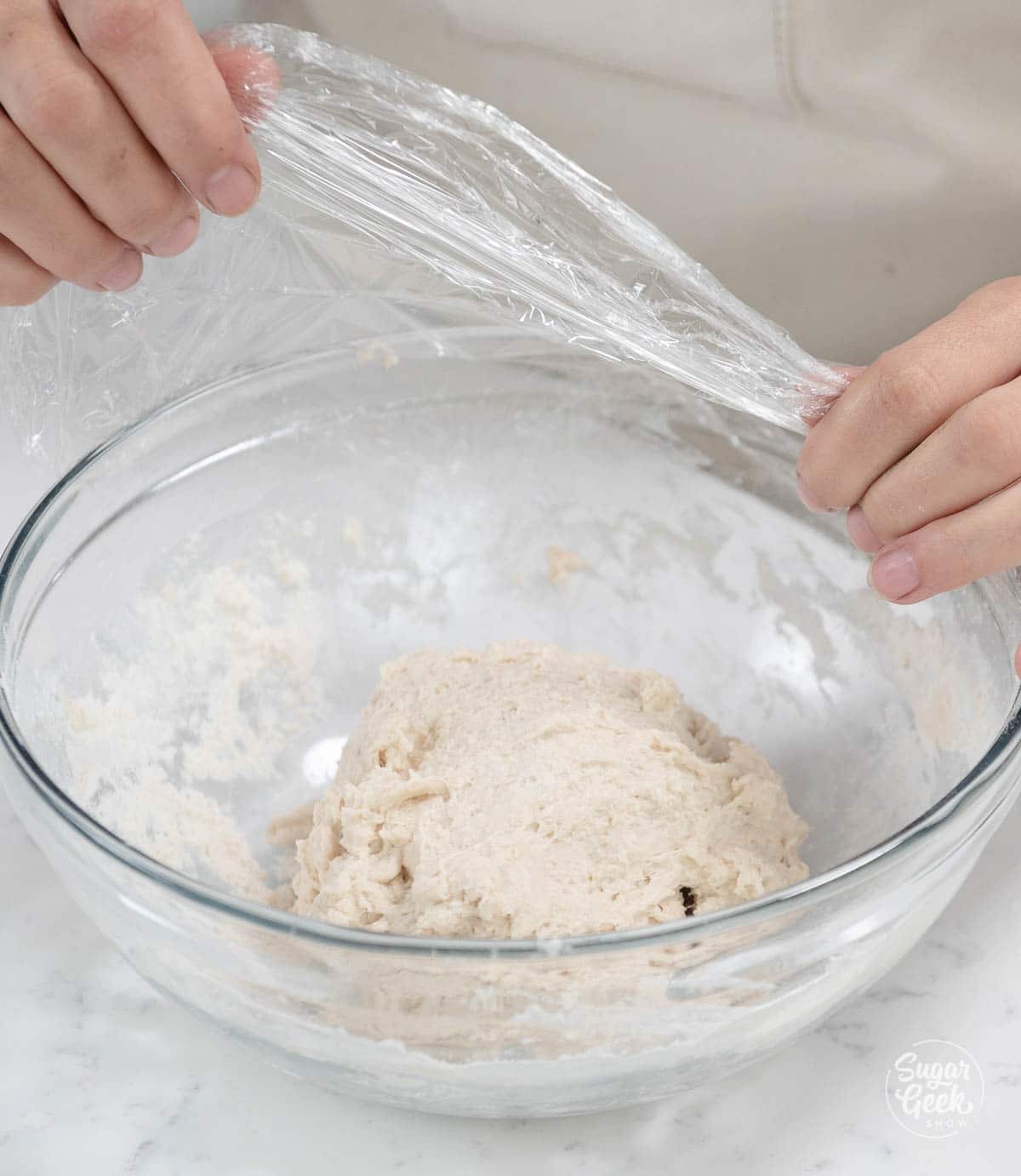
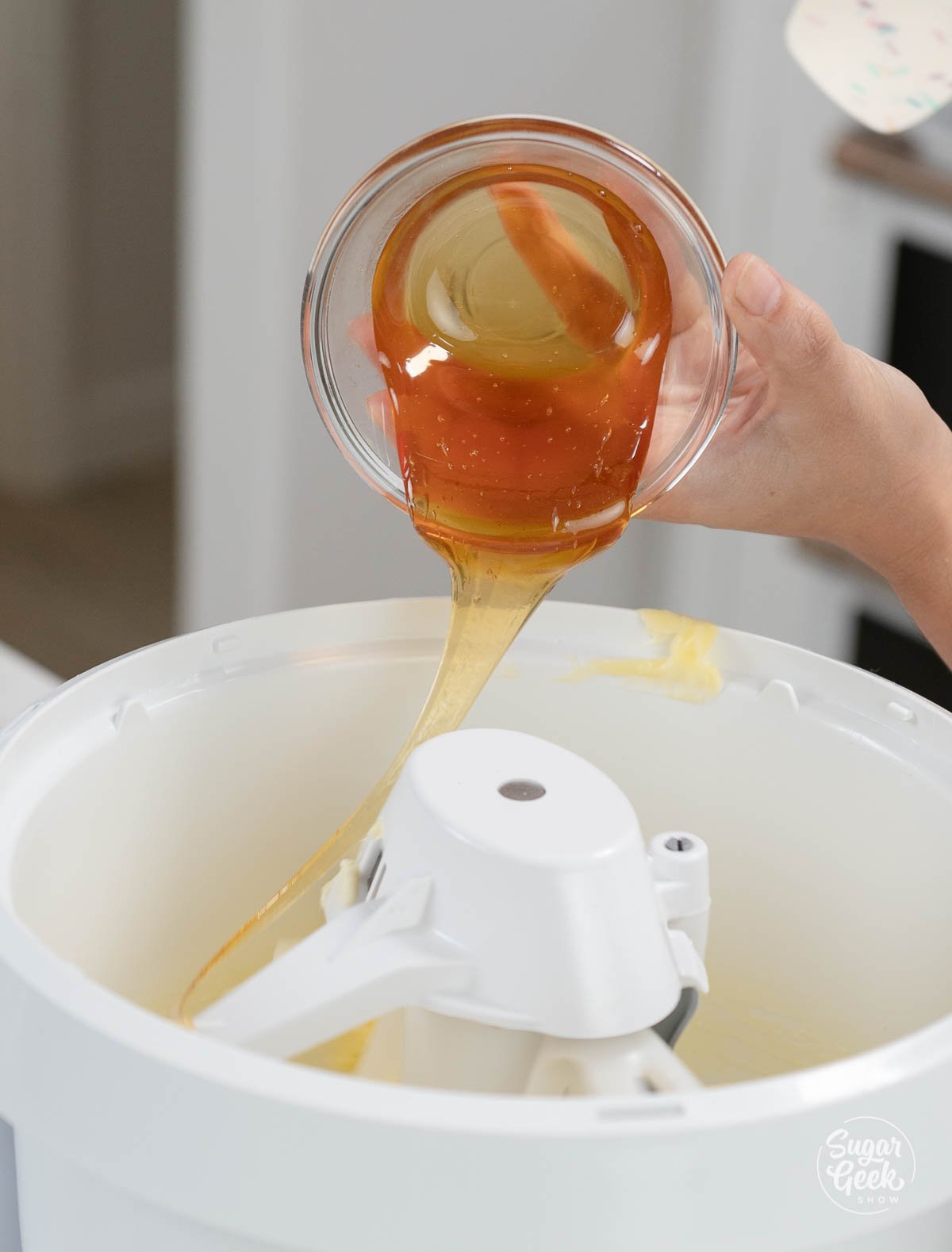
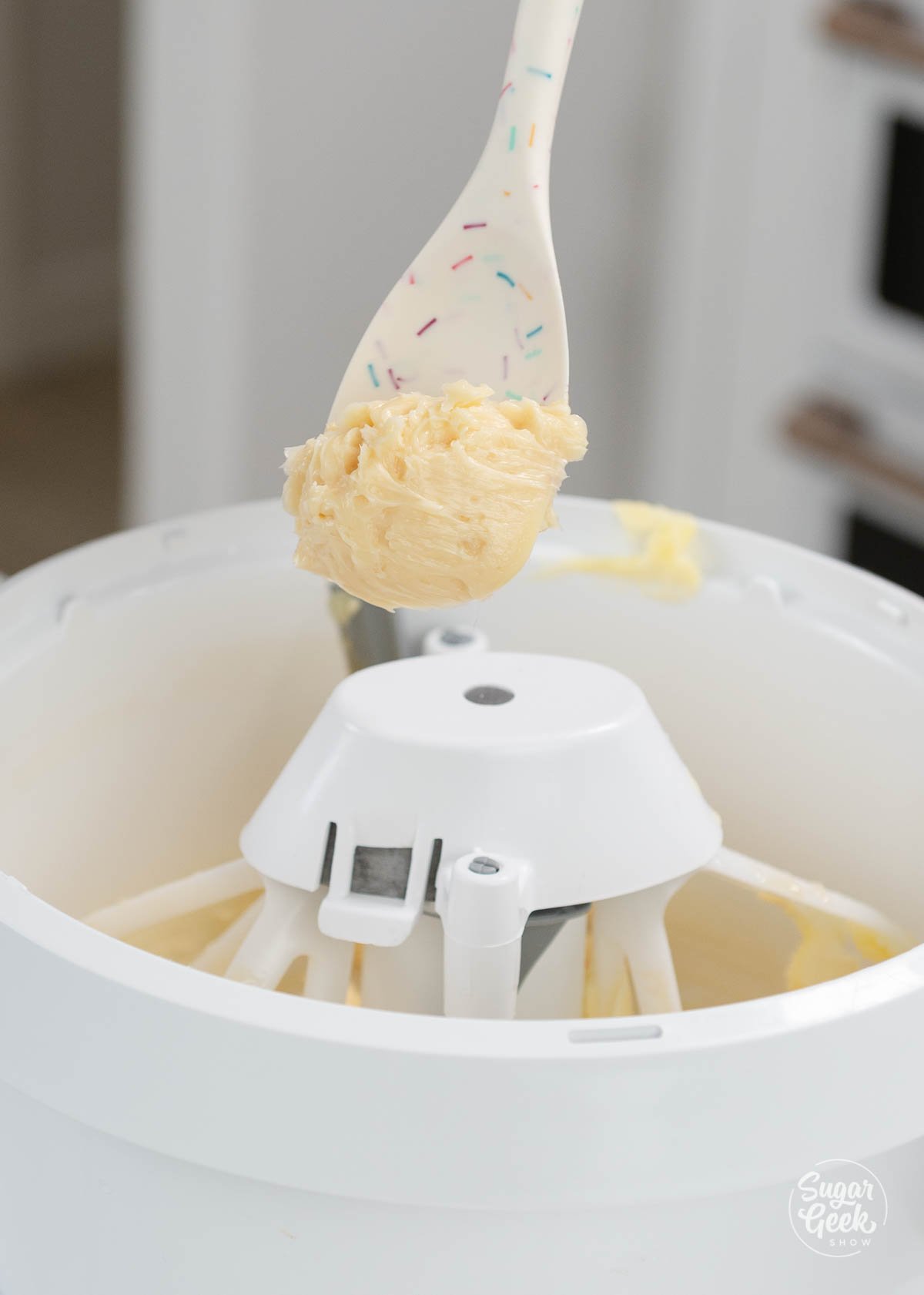

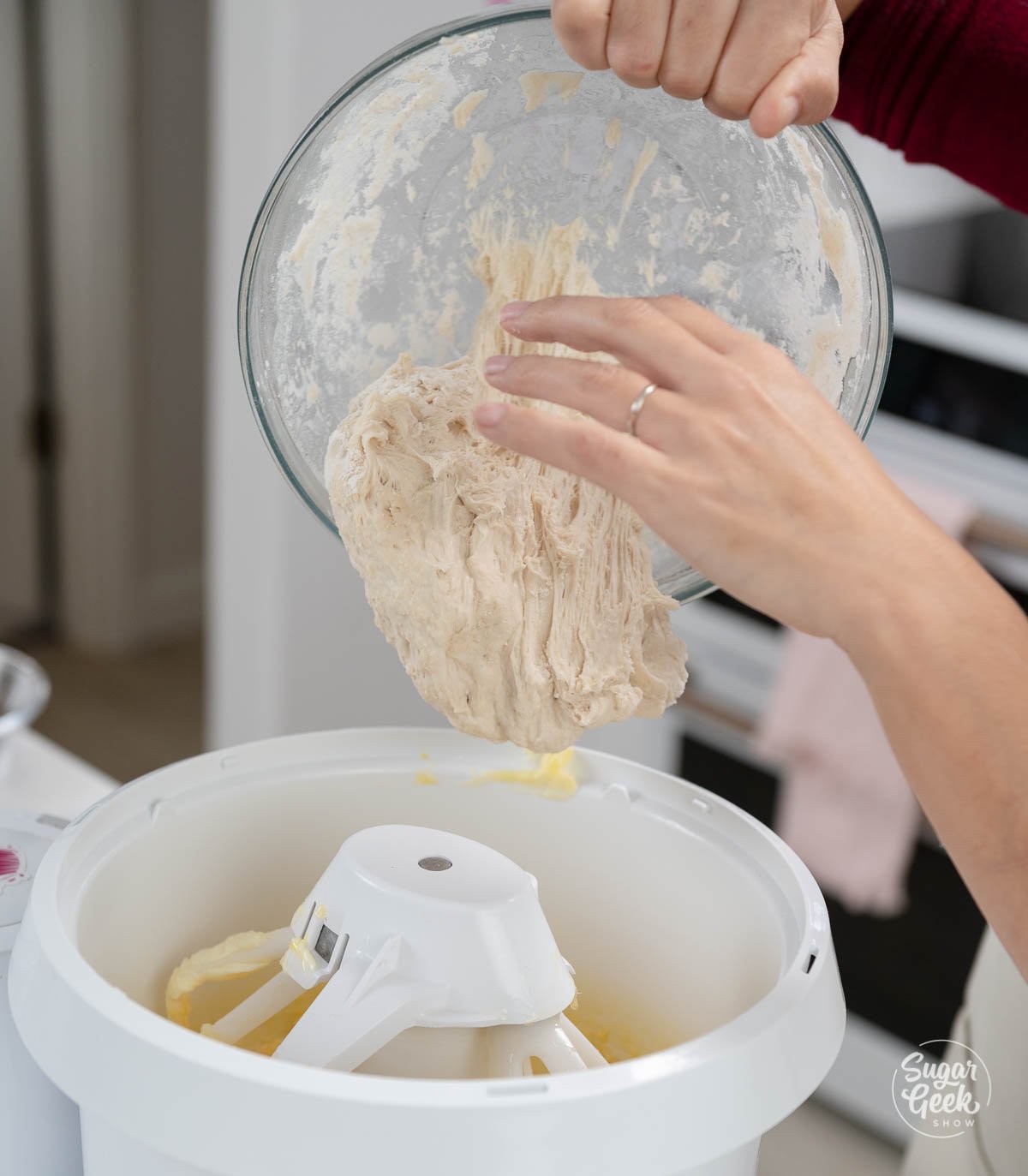
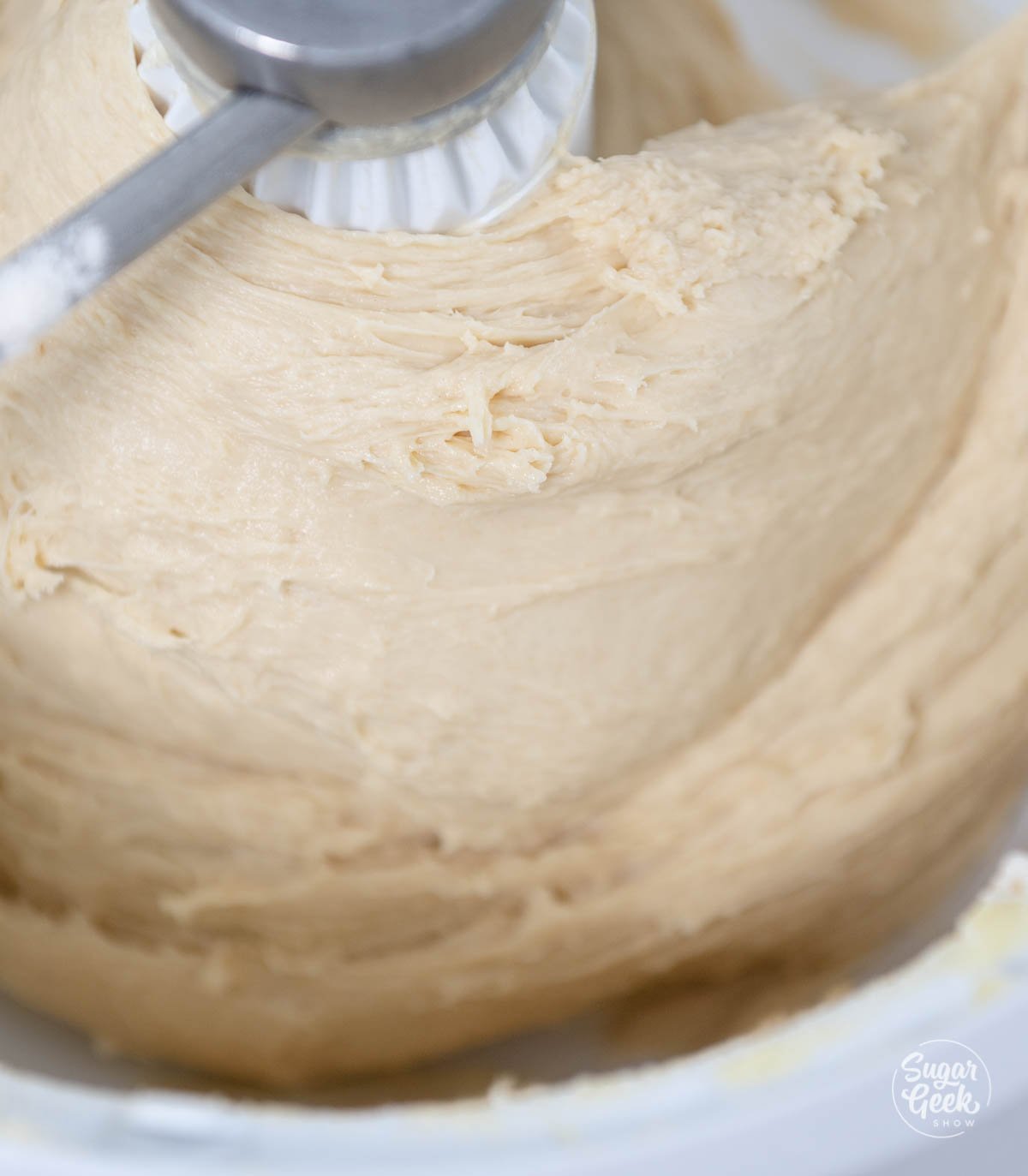
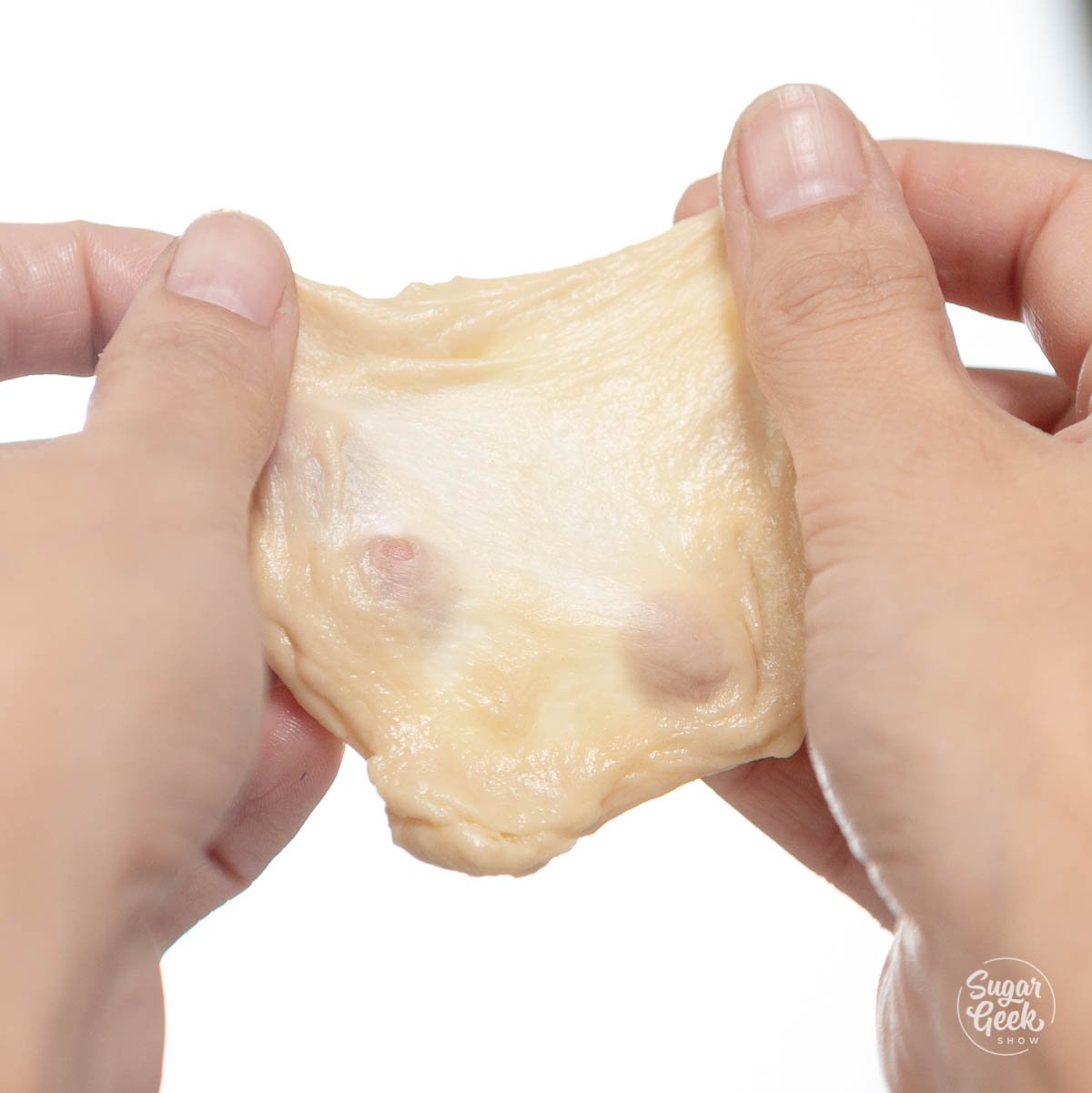
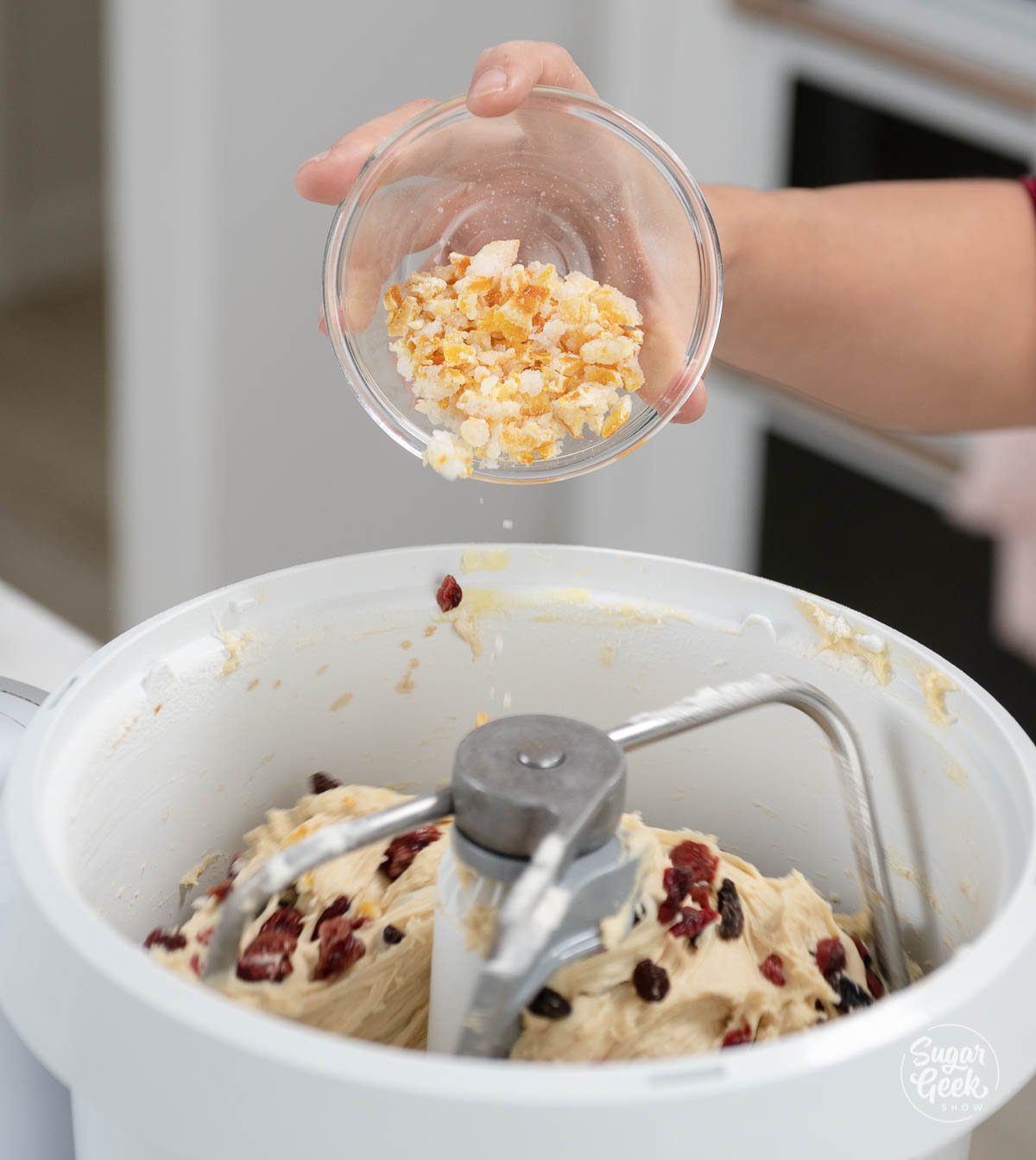
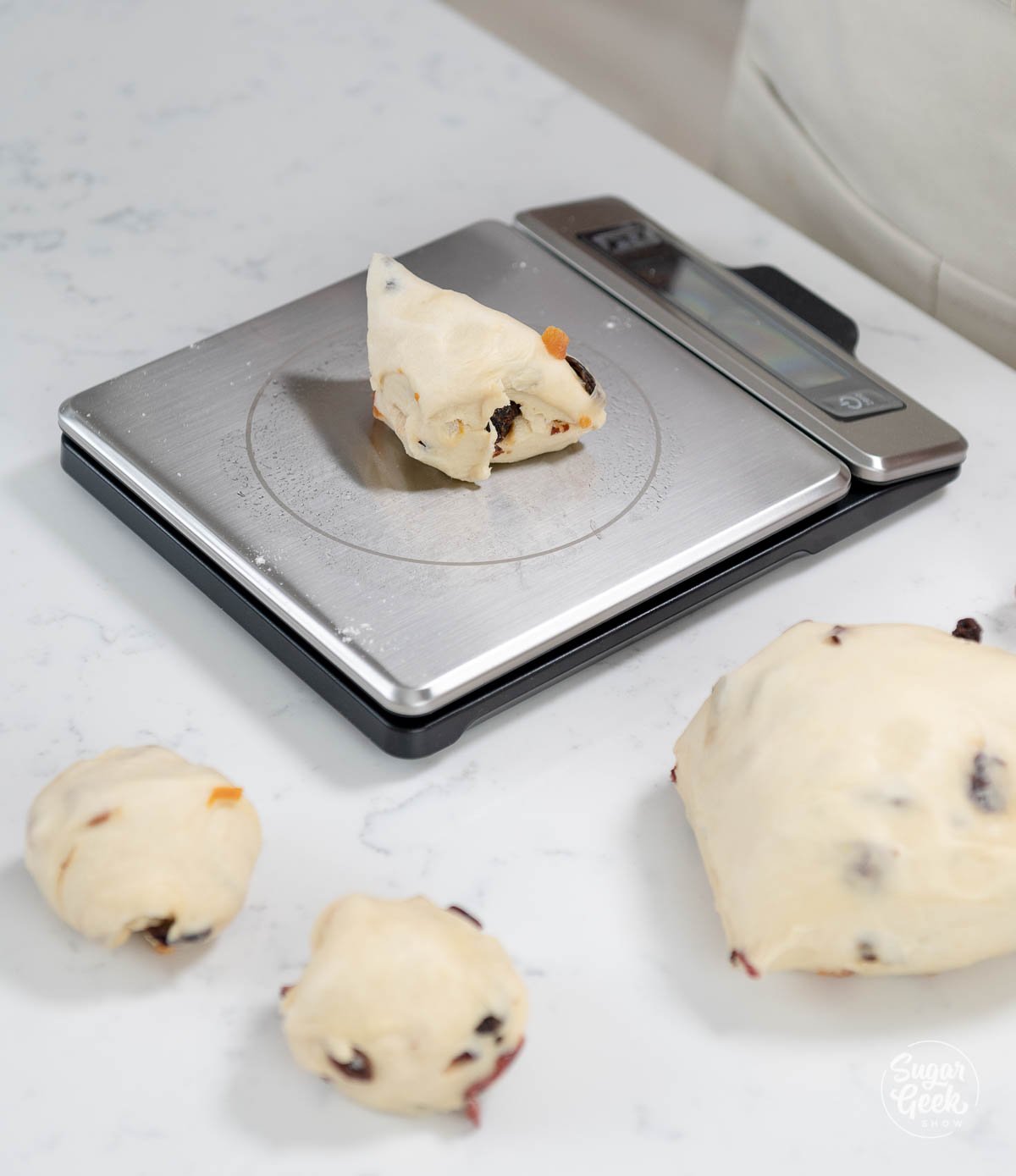
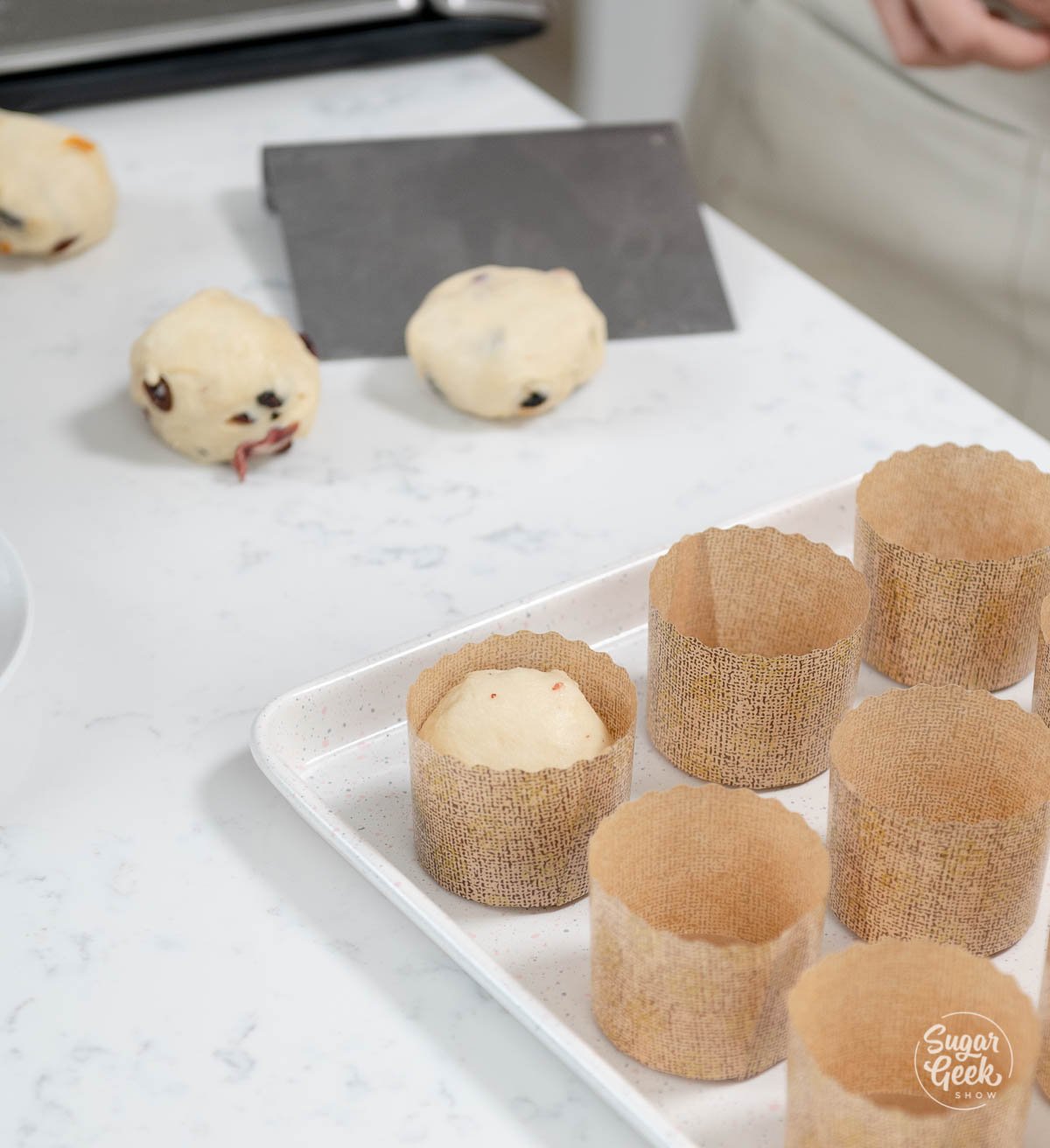
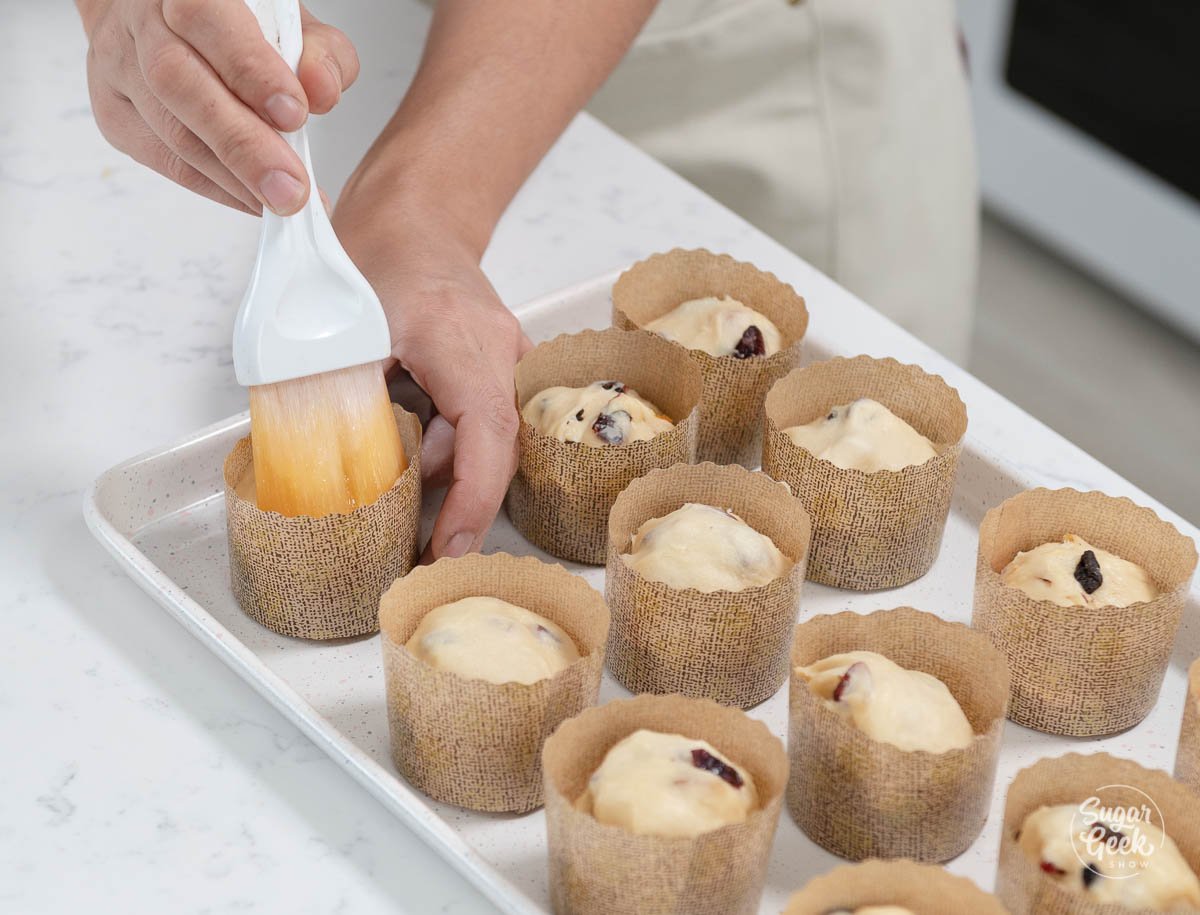
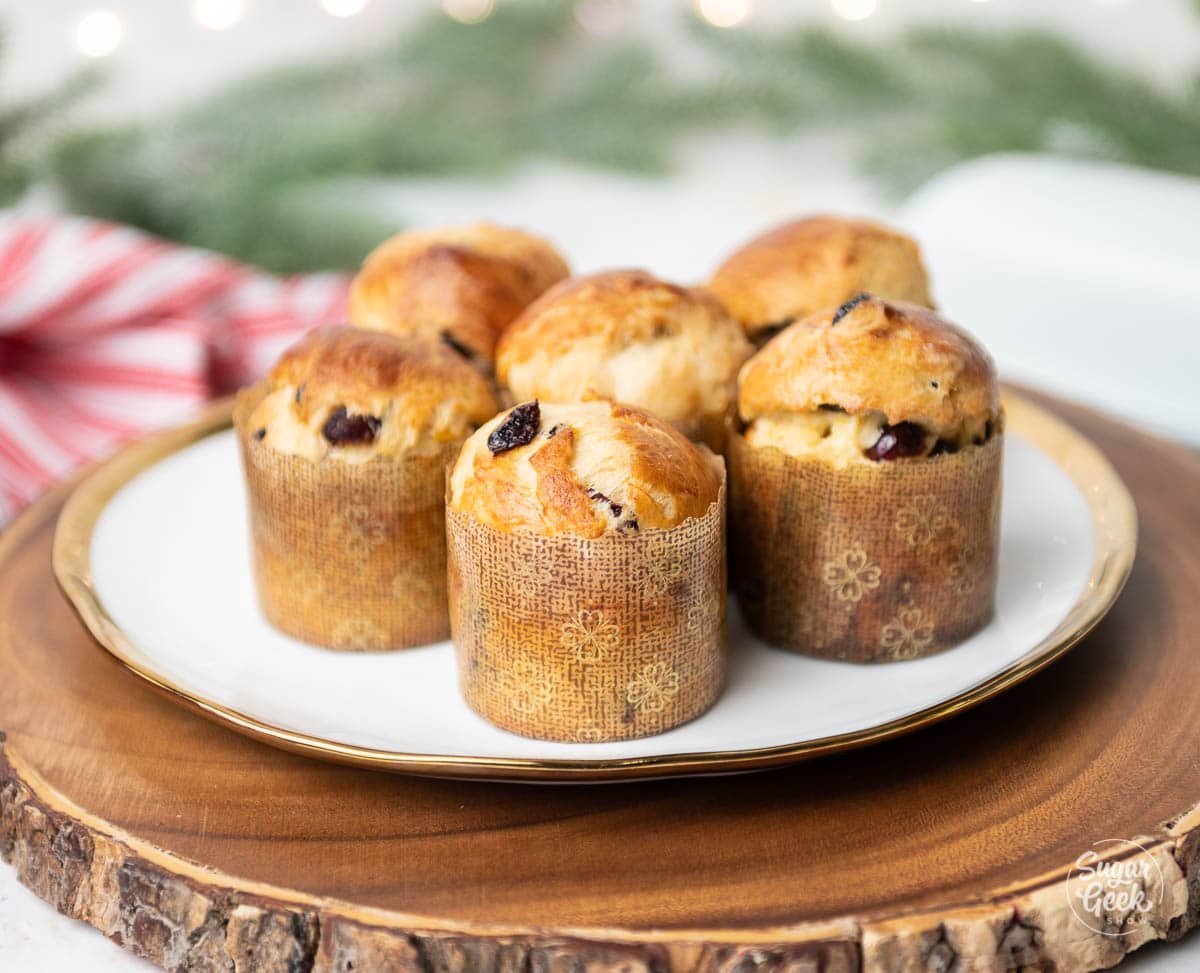
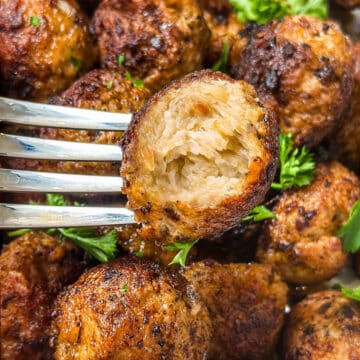
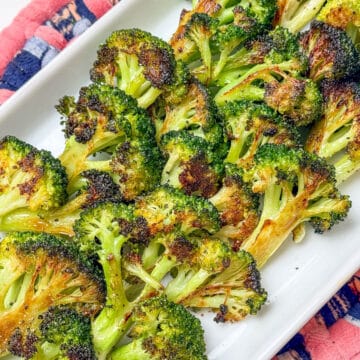
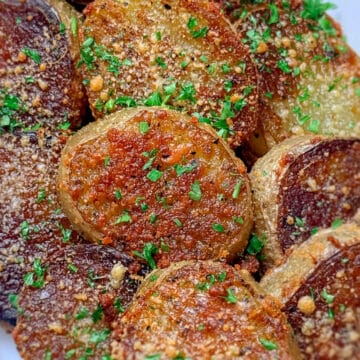
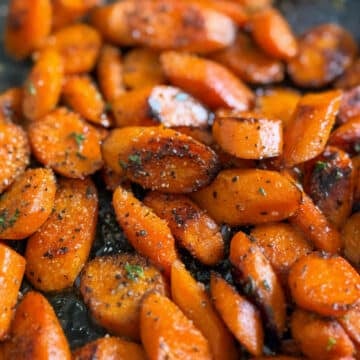
Leave a Reply